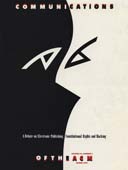March 1991 - Vol. 34 No. 3

Features
Legally speaking: is information property?
This column will discuss why the law has traditionally resisted characterizing information as the sort of thing that can be private property, and will speculate about why judges may be more receptive nowadays to assertions that information should be treated as property. This new attitude is illustrated by a 1987 U.S. Supreme Court decision which upheld criminal convictions based solely on the misappropriation of information which the Court found to be the property of one of the defendants' employers.
Electronic frontier: coming into the country
Imagine discovering a continent so vast that it may have no end to its dimensions. Imagine a new world with more resources than all our future greed might exhaust, more opportunities than there will ever be entrepreneurs to exploit, and a peculiar kind of real estate that expands with development.
Justification of printed music
There is increasing interest in the use of computer systems for editing and printing sheet music [3, 19]. Music processing lags far behind text processing because of the complexities of music notation. Most music published today is still laid out by hand; while computers may be used, decisions about music-symbol placement are made by people. Much research remains to be done into computational methods of encoding the myriad rules of music notation. Individual rules are not difficult to formulate; it is the complex interaction among rules which is difficult to describe and control. In this article we focus on one aspect of music notation: the horizontal spacing of music to produce a right- and left- justified result.



